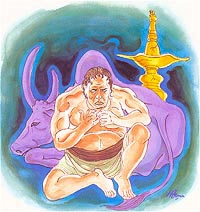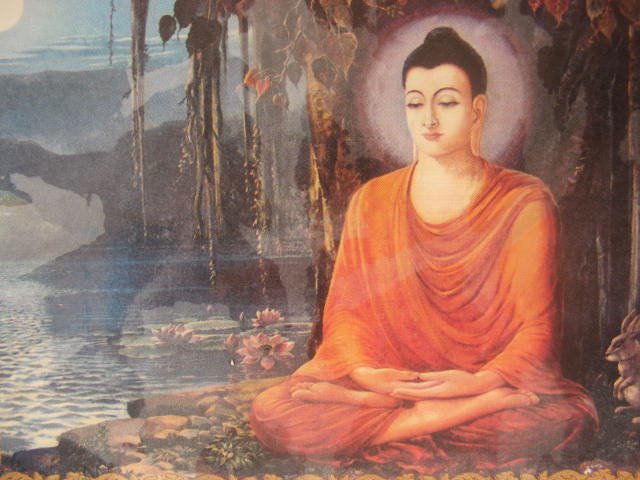30 04 2012 MONDAY LESSON 595 FREE ONLINE eNālāndā
Research And Practice UNIVERSITY And
THE BUDDHISTONLINE GOOD NEWS LETTER by ABHIDHAMMA RAKKHITA through http://sarvajan.ambedkar.org
Dhammapada:
Verses and Stories Body Fattens - Mind Does Not

Verse
152. Body Fattens - Mind Does Not
Just as the ox grows old
so this man of little learning:
his fleshiness increases,
his wisdom doesn’t grow.
Explanation: The person who has scarcely heard the Teaching
grows in physique, like a fattened bull. Although his body grows, his self
understanding does not.
V.
FIVE TYPES OF BUDDHIST STUDY AND PRACTICE
MAHAYANA AND HINAYANA COMPARED
PURE LAND
BUDDHA RECITATION
EIGHT CONSCIOUSNESSES
ONE HUNDRED DHARMAS
ONE HUNDRED DHARMAS
http://www.drbu.org/dictionary/one-hundred-dharmas
One
Hundred Dharmas
The
One Hundred Dharmas are a general categorization of all dharmas according to
the Consciousness-Only School of the Mahayana.
All lists of dharmas are distinction-making for the purpose of
breaking attachment to harmful distinctions about our minds and the physical
world that are based on attachment to self. Other general categorizations of
all dharmas include the five skandhas and the eighteen realms.
The One Hundred Dharmas make distinctions that are more specific
and form the basis for a sophisticate and detailed Buddhist psychology of mind.
They include:
11 Form Dharmas (five skandhas—form)
8 Mind Dharmas (eight consciousnesses)
51 Dharmas Interactive with the Mind
24 Dharmas Not Interactive with the Mind
+6 Unconditioned Dharmas
—————————————————————
100 Dharmas
The One Hundred Dharmas are listed individually and discussed in
detail in the Śāstra on the Door to Understanding the Hundred Dharmas (HD).
Chinese
Terms
百法
http://www.cttbusa.org/100shastra/100dharmas1.asp
![]() THE SAGELY CITY OF TEN
THE SAGELY CITY OF TEN
THOUSAND BUDDHAS

http://online.sfsu.edu/~rone/Buddhism/Yogacara/BasicVersesAppendc.htm
http://buddhasandsages.wordpress.com/2010/03/02/100-dharmas/
http://www.acmuller.net/yogacara/outlines/100dharmas-big5.htm
The One Hundred
Dharmas
百法
Dan
Lusthaus
Based
on Vasubandhu’s Baifa mingmen lun 百法明門論
Mahaayaana `satadharmaa-prakaa`samukha `saastra
(Lucid Introduction to the One Hundred Dharmas)
T.31.1614
I. The Eight
Consciousnesses Citta-dharma 心法,八識
1. |
cak.sur-vij~naana |
眼識 |
2. |
`srotra-vij~naana |
耳識 |
3. |
ghraa.na-vij~naana |
鼻識 |
4. |
jihvaa-vij~naana |
舌識 |
5. |
kaaya-vij~naana |
身識 |
6. |
mano-vij~naana |
意識 |
7. |
manas |
意 |
8. |
aalaya-vij~naana |
阿賴耶識 |
II. Mental Associates
caitta, caitasika-dharma 心所法
citta-samprayukta-dharma
心相應法
A
Always-active
Sarvatraga 遍行
9. |
spar`sa |
觸 |
10. |
vedanaa |
受 |
11. |
cetanaa |
思 |
12. |
sa.mj~naa |
想 |
13. |
manaskaara |
作意 |
B
Specific
Viniyata 別境
14. |
chanda |
欲 |
15. |
adhimok.sa |
勝解 |
16. |
sm.rti |
念 |
17. |
samaadhi |
定 |
18. |
praj~naa |
慧 |
C
Advantageous
Ku`sala 善
19. |
`sraddhaa |
信 |
20. |
hrii |
慚 |
21. |
apatraapya |
愧 |
22. |
alobha |
無貪 |
23. |
adve.sa |
無瞋 |
24. |
amoha |
無痴 |
25. |
viirya |
精進 |
26. |
pra`srabdhi |
輕安 |
27. |
apramaada |
不放逸 |
28. |
upek.sa |
行捨 |
29. |
ahi.msaa |
不害 |
D
Mental
Disturbances Kle`sa 煩惱
30. Appropriational intent |
raaga |
貪 |
31. Aversion |
pratigha |
瞋 |
32. Stupidity |
muu.dhi |
痴 |
33. Arrogance |
maana |
慢 |
34. Doubt |
vicikitsaa |
疑 |
35. Perspectivality |
d.r.s.ti |
惡見 |
E
Secondary Mental
Disturbances Upakle`sa 隨煩惱
36. Anger |
krodha |
忿 |
|
37. Enmity |
upanaaha |
恨 |
|
38. Resist recognizing own faults |
mrak.sa |
覆 |
|
39. [verbal] maliciousness |
pradaasa |
惱 |
|
40. Envy |
iirasyaa |
嫉 |
|
41. Selfishness |
maatsarya |
慳 |
|
42. Deceit |
maayaa |
誑 |
|
43. Guile |
`saa.thya |
諂 |
|
44. Harmfulness |
vihi.msaa |
害 |
|
45. Conceit |
mada |
憍 |
|
46. Shamelessness |
aahriikya |
無慚 |
|
47. Non-embarrassment |
anapatraapya |
無愧 |
|
48. Restlessness |
auddhatya |
掉舉 |
|
49. Mental fogginess |
styaana |
惛沈 |
|
50. Lack of Faith/trust |
aa`sraddhya |
不信 |
|
51. Lethargic negligence |
kausiidya |
懈怠 |
|
52. Carelessness |
pramaada |
放逸 |
|
53. Forgetfulness |
mu.sitasm.rtitaa |
失念 |
|
54. Distraction |
vik.sepa |
散亂 |
|
55. Lack of [self-]Awareness |
asa.mprajanya |
不正知 |
|
F
Indeterminate Aniyata
不定
56. Remorse |
kauk.rtya |
悔 |
57. Torpor |
middha |
隨眠 |
58. Initial mental application |
vitarka |
尋 |
59. [subsequent] Discursive |
vicaara |
伺 |
III. Form
Ruupa-dharma 色法
60. Eye |
cak.sus |
眼 |
||
61. Ear |
`srotra |
耳 |
||
62. Nose |
ghraa.na |
鼻 |
||
63. Tongue |
jihvaa |
舌 |
||
64. Body |
kaaya |
身 |
||
65. [visible] form |
ruupa |
色 |
||
66. Sound |
`sabda |
聲 |
||
67. Smell |
gandha |
香 |
||
68. Taste |
rasa |
味 |
||
69. Touch |
spra.s.tavya |
觸 |
||
70. ‘Formal’ Thought-objects |
dharmaayatanikaani ruupaani |
法處所攝色 |
||
a. Concrete form analyzed to |
極略色 |
|
||
b. Non-concrete form (space, |
極迥色 |
|
||
c. Innermost impression of |
受所引色 |
|
||
d. Forms arising through False |
遍計所起色 |
|
||
e. Forms produced and mastered in |
定所生自在色 |
|
||
IV. Embodied-conditioning Not
Directly [perceived] by Citta
Citta-viprayukta-sa.mskaara-dharma
心不相應行法
71. (karmic) Accrual |
praapti |
得 |
72. Life-force |
jiivitendriya |
命根 |
73. Commonalities by species |
nikaaya-sabhaaga |
眾同分 |
74. Differentiation of species |
visabhaaga |
異生法 |
75. Attainment of Thoughtlessness |
asa.mj~ni-samaapatti |
無想定 |
76. Attainment of Cessation |
nirodha-samaapatti |
滅盡定 |
77. [realm of] Thoughtless |
aasa.mj~nika |
無想果 |
78. ‘Name’ body |
naama-kaaya |
名身 |
79. ‘Predicate’ body |
pada-kaaya |
句身 |
80. ‘Utterance’ body |
vya~njana-kaaya |
文身 |
81. Birth/arising |
jaati |
生 |
82. Continuity/abiding |
sthiti |
住 |
83. Aging/decaying |
jaraa |
老 |
84. Impermanence |
anityataa |
無常 |
85. Systematic Operation |
prav.rtti |
流轉 |
86. Determinant (karmic) |
pratiniyama |
定異 |
87. Unifying |
yoga |
相應 |
88. Speed |
jaava |
勢速 |
89. Seriality |
anukrama |
次第 |
90. Area (space) |
de`sa |
方 |
91. Time |
kaala |
時 |
92. Number/calculation |
sa.mkhyaa |
數 |
93. Synthesis |
saamagrii |
和合性 |
94. Otherwiseness |
anyathaatva |
不和合性 |
V. Unconditioned Dharmas
Asa.msk.rta-dharmas 無為法
95. Spatiality |
aakaa`sa |
虛空 |
96. Cessation through |
pratisa.mkhyaa-nirodha |
擇滅無為 |
97. Cessation without |
apratisa.mkhyaa-nirodha |
非擇滅無為 |
98. ‘Motionless’ Cessation |
aani~njya |
不動滅無為 |
99. Cessation of Associative-thinking |
sa.mj~naa-vedayita-nirodha |
想受滅無為 |
100. Ipseity |
tathataa |
如來 |
http://www.zhaxizhuoma.net/DHARMA/Tripitaka/lucid100dharmas.htm
|
Lucid By |
|
I. |
|
Citta-dharma |
Xin-fa, Ba-shi |
|
II. |
caitta, caitasika-dharma |
Xin-suo fa, xin-xiang-ying fa |
|
|
A. |
Always-active |
Sarvatraga |
Bian-xing |
|
B. |
Specific |
Viniyata |
Bie-jing |
|
C. |
Advantageous |
Ku`sala |
Shan |
|
D. |
Mental Disturbances |
Kle`sa |
Fan-nao |
|
E. |
Secondary Mental Disturbances |
Upakle`sa |
Sui-fan-nao |
|
F. |
Indeterminate
|
Aniyata |
Bu-ding |
|
III. |
|
Ruupa-dharma |
Se-fa |
|
IV. |
Embodied-conditioning Not Directly [perceived] by Citta
|
Citta-viprayukta-sa.mskaara-dharma |
Xin-bu-xiang-ying-xing-fa |
|
V. |
Asa.msk.rta-dharmas |
Wu-wei-fa |
Return to TOP.
Page last updated on July 10, 2005 .

VOICE OF SARVAJAN









30 04 2012 MONDAY LESSON 595 FREE ONLINE eNālāndā
Research And Practice UNIVERSITY And
THE BUDDHISTONLINE GOOD NEWS LETTER by ABHIDHAMMA RAKKHITA through http://sarvajan.ambedkar.org
84000 Khandas divided into 275250 as to the
stanzas of the original text and
into 361550 divided into 2547 banawaras containing 737000 stanzas and
29368000
separate letters
Awakeness Practices
All 84,000 Khandas As Found in the
Pali Suttas
Traditionally
the are 84,000 Dharma Doors -
84,000 ways to get Awakeness. Maybe so;
certainly the Buddha taught a
large number of practices that lead to
Awakeness. This web page attempts
to catalogue those found in the Pali Suttas
(DN, MN, SN, AN, Ud & Sn 1).
There are 3 sections:
The discourses of Buddha
are divided into 84,000, as to
separate addresses. The division includes all
that was spoken by Buddha.”I
received from Buddha,” said Ananda, “82,000
Khandas, and from the
priests 2000; these are 84,000 Khandas maintained
by me.” They are divided into
275,250, as to the stanzas of the original text,
and into 361,550, as to the stanzas
of the commentary. All the discourses
including both those of Buddha and
those of the commentator, are divided
into 2,547 banawaras, containing
737,000 stanzas, and 29,368,000 separate letters.
WISDOM IS POWER
Awakened One Shows the Path to
Attain Ultimate Bliss
Anyone Can Attain Ultimate Bliss
Just Visit:
COMPUTER IS AN ENTERTAINMENT
INSTRUMENT!
INTERNET!
IS
ENTERTAINMENT
NET!
TOBE MOST APPROPRIATE!
Using such an instrument
The FREE ONLINE eNālāndā Research And Practice UNIVERSITY has been re-organized to function
through the following
Schools of Learning :
Buddha Taught his Dhamma Free of
cost, hence the Free- e-Nālandā
follows suit
As the Original Nālandā University
did not offer any Degree, so also the Free e-Nālandā
University.
Main Course Programs:
I.
KAMMA
REBIRTH
AWAKEN-NESS
BUDDHA
THUS COME ONE
DHAMMA
II.
ARHAT
FOUR HOLY TRUTHS
EIGHTFOLD PATH
TWELVEFOLD CONDITIONED ARISING
BODHISATTVA
PARAMITA
SIX PARAMITAS
III.
SIX SPIRITUAL POWERS
SIX PATHS OF REBIRTH
TEN DHARMA REALMS
FIVE SKANDHAS
EIGHTEEN REALMS
FIVE MORAL PRECEPTS
IV.
MEDITATION
MINDFULNESS
FOUR APPLICATIONS OF MINDFULNESS
LOTUS POSTURE
SAMADHI
CHAN SCHOOL
FOUR DHYANAS
FOUR FORMLESS REALMS
V.
FIVE TYPES OF BUDDHIST STUDY AND
PRACTICE
MAHAYANA AND HINAYANA COMPARED
PURE LAND
BUDDHA RECITATION
EIGHT CONSCIOUSNESSES
ONE HUNDRED DHARMAS
EMPTINESS
VI.
DEMON
LINEAGE
with
Level I: Introduction to Buddhism
Level II: Buddhist Studies
TO ATTAIN
Level III: Stream-Enterer
Level IV: Once - Returner
Level V: Non-Returner
Level VI: Arhat
Jambudvipa,
i.e, PraBuddha Bharath scientific
thought in
mathematics,
astronomy,
alchemy,
and
anatomy
Philosophy and Comparative
Religions;
Historical Studies;
International Relations and Peace
Studies;
Business Management in relation to
Public Policy and Development Studies;
Languages and Literature;












UPASAKA JAGATHEESAN CHANDRASEKHARAN
every second - everything is changing
( Nothing is permanent )
BE EVER HAPPY, WELL AND SECURE
MAY ALL SENTIENT AND NON-SENTIENT BEINGS BE EVER
HAPPY
MAY YOU ALWAYS HAVE CALM, QUIET,
ALERT,ATTENTIVE AND
EQUANIMITY MIND WITH A CLEAR UNDERSTANDING THAT
EVERYTHING IS CHANGING



































